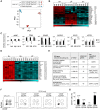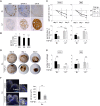Quantification of regenerative potential in primary human mammary epithelial cells
- PMID: 26071498
- PMCID: PMC4582177
- DOI: 10.1242/dev.123554
Quantification of regenerative potential in primary human mammary epithelial cells
Abstract
We present an organoid regeneration assay in which freshly isolated human mammary epithelial cells are cultured in adherent or floating collagen gels, corresponding to a rigid or compliant matrix environment. In both conditions, luminal progenitors form spheres, whereas basal cells generate branched ductal structures. In compliant but not rigid collagen gels, branching ducts form alveoli at their tips, express basal and luminal markers at correct positions, and display contractility, which is required for alveologenesis. Thereby, branched structures generated in compliant collagen gels resemble terminal ductal-lobular units (TDLUs), the functional units of the mammary gland. Using the membrane metallo-endopeptidase CD10 as a surface marker enriches for TDLU formation and reveals the presence of stromal cells within the CD49f(hi)/EpCAM(-) population. In summary, we describe a defined in vitro assay system to quantify cells with regenerative potential and systematically investigate their interaction with the physical environment at distinct steps of morphogenesis.
Keywords: Basal; Branching morphogenesis; CD10; Collagen gel; Luminal; Mammary stem cell; Organoid; Primary human mammary epithelial cells; Progenitor cells; Regenerative potential; Terminal ductal-lobular units.
© 2015. Published by The Company of Biologists Ltd.
Figures







References
-
- Asselin-Labat M.-L., Sutherland K. D., Barker H., Thomas R., Shackleton M., Forrest N. C., Hartley L., Robb L., Grosveld F. G., van der Wees J. et al. (2007). Gata-3 is an essential regulator of mammary-gland morphogenesis and luminal-cell differentiation. Nat. Cell Biol. 9, 201-209. 10.1038/ncb1530 - DOI - PubMed
Publication types
MeSH terms
Substances
Associated data
- Actions
LinkOut - more resources
Full Text Sources
Other Literature Sources
Molecular Biology Databases
Miscellaneous

